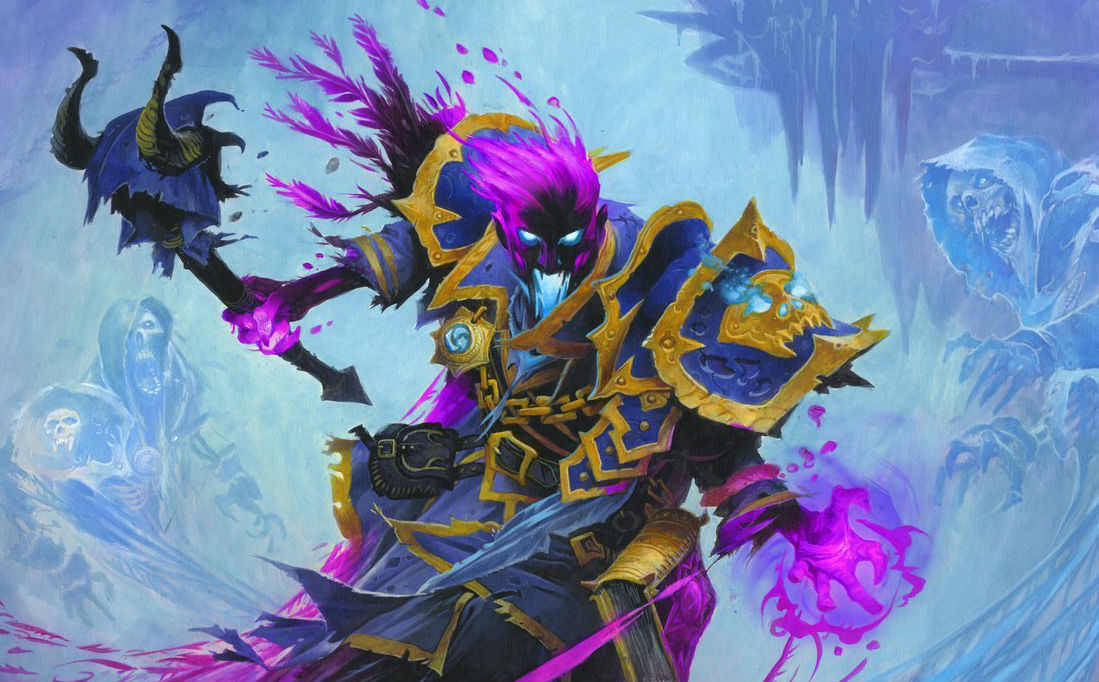
Knights of the Frozen Throne is one of Hearthstone's stranger expansions. From the brilliant Death Knight Hero Cards to the excellent (and free) adventure content, it does a lot of things better than Journey to Un'Goro, which I previously labeled the best set since League of Explorers. And yet less than a fortnight after launch I'd lost almost all desire to play on ladder. The easiest direction to point the blame at is Druid, which Blizzard's designers inexplicably saw fit to hand several god-tier cards that shored up traditional weaknesses at a time when the class was already dangerously strong. But there are more complex reasons why Knights of the Frozen Throne hasn't quite worked.
First, let's talk about the successes, the biggest of which are the Hero Cards. These are nine new legendaries (one for each class) with nutty effects, and because they cost between 5 and 10 Mana to cast, they inherently promote later game strategies—something Hearthstone fans have been calling for since forever. Once played, your hero is transformed into a Death Knight and a unique effect happens. For instance, play Warlock's Bloodreaver Gul'dan and all friendly demons that died this game will be resummoned. Hello Doomguard, my old friend. Hero Cards also grant the player an immediate 5 armor, which helps make them playable against aggro strategies, and an upgraded hero power. In Bloodreaver's case it's the bonkers Siphon Life, which deals three damage to a target and heals you by the same amount. An insane six health swing for 2 Mana every turn.
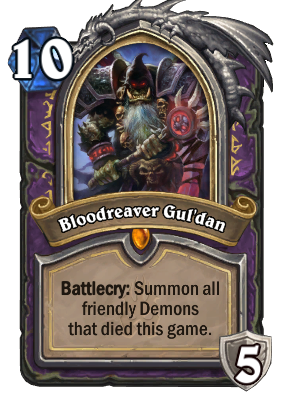
As former world champ Firebat noted when the first Hero Card was revealed, the inspiration was clearly Lord Jarraxus, another Warlock card which involved total transformation of your hero. Firebat also noted that playing Jarraxus was never not fun, and the same has proved true for these new heroes. Whether you're stitching together zombie Beasts as the Hunter's Deathstalker Rexxar or machinegunning your opponent to death with free hero powers as the Priest's Shadowreaper Anduin, all the Hero Cards are a blast to play, though vary wildly in competitive viability. I've even managed to pull off the Paladin's "Exodia" combo, which involves keeping four apocalyptic but small horsemen alive on the same turn, at which point you instantly win the game. Special thanks to my opponent for not conceding once it became clear what was happening—seeing those fireworks go off is one of my all-time favourite Hearthstone moments.
Aside from the fun associated with these powerful effects, there are more design elements to admire about the Hero Cards. I think of them as soft versions of Journey to Un'Goro's Quests in the sense that they also create alternate win conditions, but don't require you to gimp your entire deck in order to activate them. It's possible to jam Frost Lich Jaina into a Mage deck without any of the Elemental cards which seemingly synergise with her. In contrast, Journey to Un'Goro's Quests ask you to build your whole deck around their requirements. Blizzard also learned from the salt outpouring at the Quests being legendary rarity by giving players a free Hero Card at the launch of Knights of the Frozen Throne, and tweaking the pack opening algorithm to ensure we no longer receive duplicate legendaries.
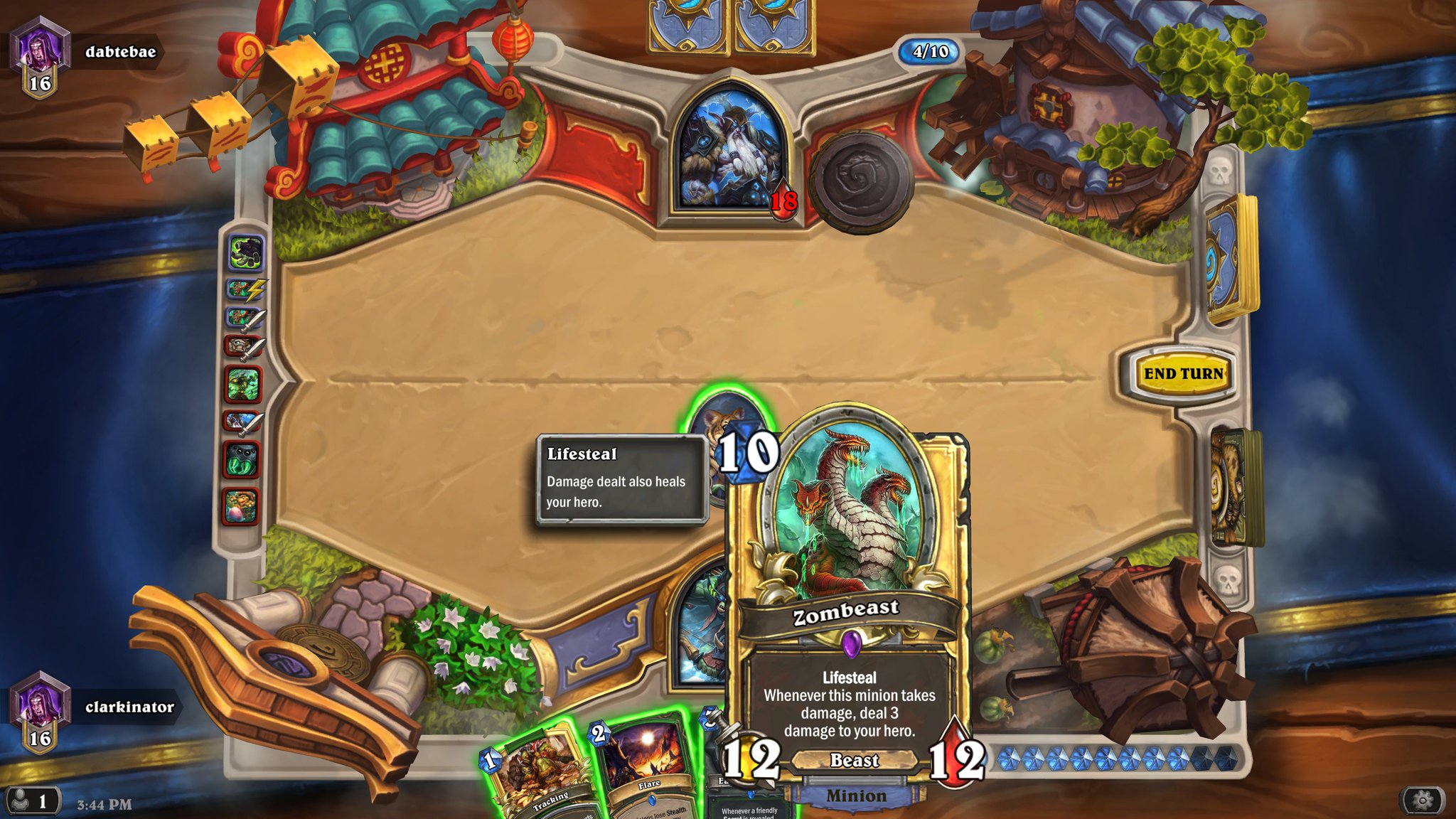
Hero Cards are a triumph then, and even the current weak ones may get better with future support. I'm confident in saying that Frozen Throne landed its big theme better than Un'Goro did. Frozen Throne also includes the least amount of unplayable 'pack filler' cards, and absolutely nailed The Lich King in terms of flavour. The card itself is strong—an 8/8 with Taunt that draws a powerful bespoke card every turn it's left alive, much like Ysera—but contrary to initial assessments, isn't so good that you can just jam it into any deck. Whilst some of the cards he can net you are unbelievably powerful, in particular the Frostmourne weapon, others prove too situational to even play in many games. That kind of opportunity cost is good design rather than bad balance.
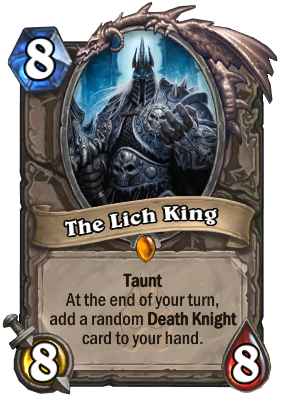
Also great are the Lich King-related PvE missions. These represent the first fruit of the free adventure content which Blizzard promised would follow the switch to three full expansions in this cycle of the Standard format. What we got were two weeks of fairly standard but flavourful boss encounters themed around the WoW raid, followed by a game-changer in the main battle against the Lich King.
Depending on which class you played, the encounter is fought with a unique condition. For instance, if you're playing Hunter you'll take 2 damage for every minion in your deck at the start of the game, forcing you to go all-in on spells and weapons instead. Brilliantly, the Priest's only restriction is that you can't use emotes. Because everyone knows Priest mains are the worst.
Keep up to date with the most important stories and the best deals, as picked by the PC Gamer team.
The reward for winning with all nine classes is also worthwhile: a new golden hero portrait based on Arthas, the golden boy Paladin who got transformed into ol' frosty fingers.
Less really is more
The upshot of basing a set around high value, relatively expensive cards is that—miraculously—for the first time anyone can remember, the metagame has actually slowed slightly. But what it hasn't done is shift enough. A large reason why is that Frozen Throne is the second set of the year. Whereas Un'Goro was accompanied by a full rotation (which is when the three oldest expansions became unplayable in the Standard format), Frozen Throne doesn't benefit from the same freshen up—and it shows. Many of the same decks remain dominant—Jade Druid, Aggro Druid, Murloc Paladin and Pirate Warrior—with the only serious addition being Priest, which has two flavours.
The 'Highlander' version runs no duplicates and relies on the combo of Raza the Chained and Shadowreaper Anduin to close out games with burst damage. The other deck is dubbed 'Big Priest', and is based on high-rolling Barnes into Y'Shaarj or an Obsidian Statue, and then resurrecting those cards for massive value. It's honestly one of the dumbest decks I've ever seen, and the fact it seems to be competitively viable is a bit depressing.
As soon as Ultimate Infestation was revealed I knew it was broken.
I think in all the excitement about what possibilities new cards present, we've lost sight of how much impact taking away the old cards has. I have some sympathy with Blizzard here. If the designers opted to remove cards more regularly there would be uproar about the cost, and I think Blizzard's concern over confusion is also legitimate in this case. Where it's harder to be sympathetic is when it comes with some of the cards that were printed for Frozen Throne. I consider myself a decent player, but am by no means a design expert, and as soon as Ultimate Infestation was revealed I knew it was broken. I can only imagine Blizzard's balance team found getting to turn 10 harder against each other than it's proved in practice.
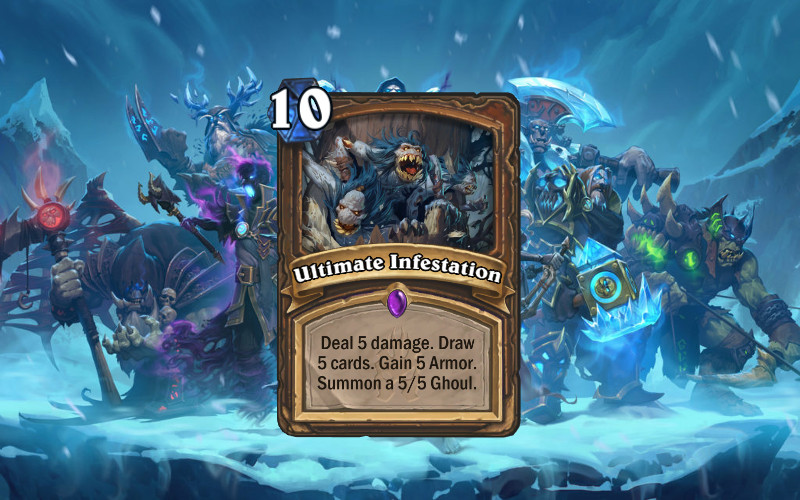
Five of the best Knights of the Frozen Throne cards
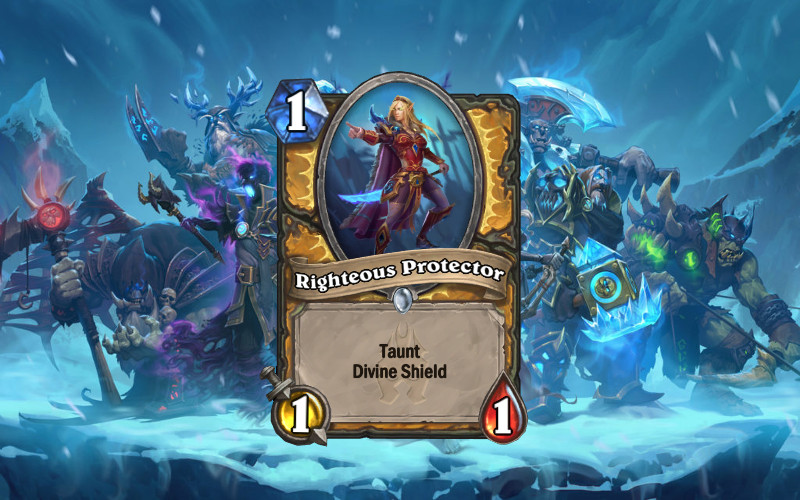
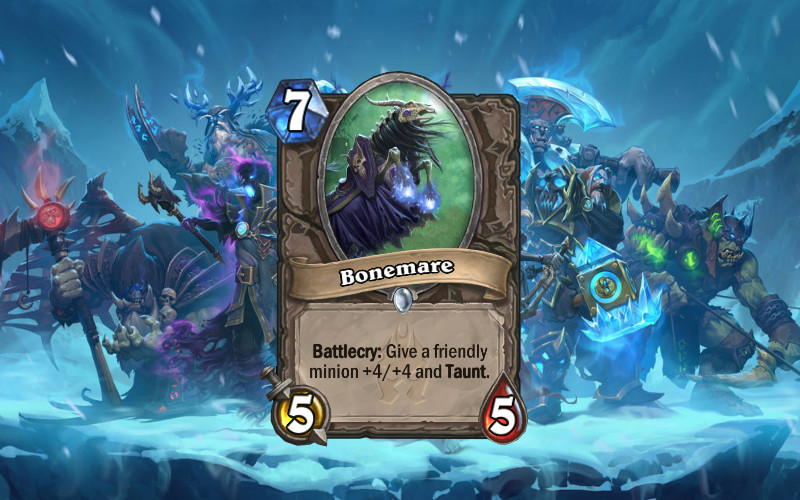
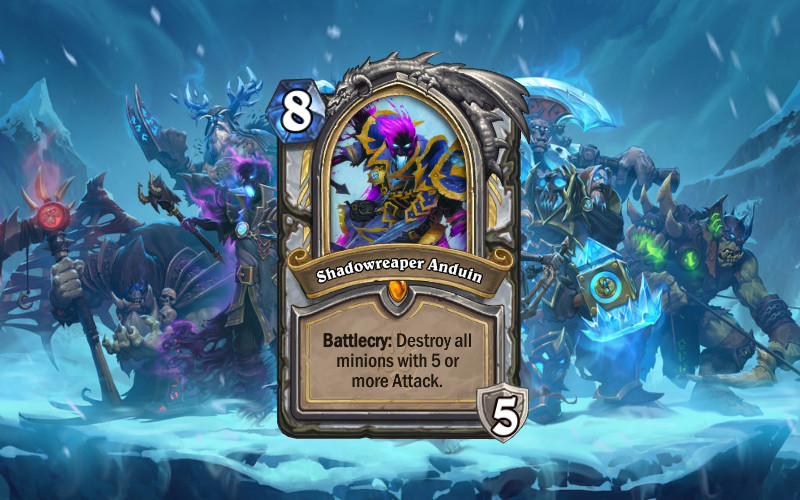
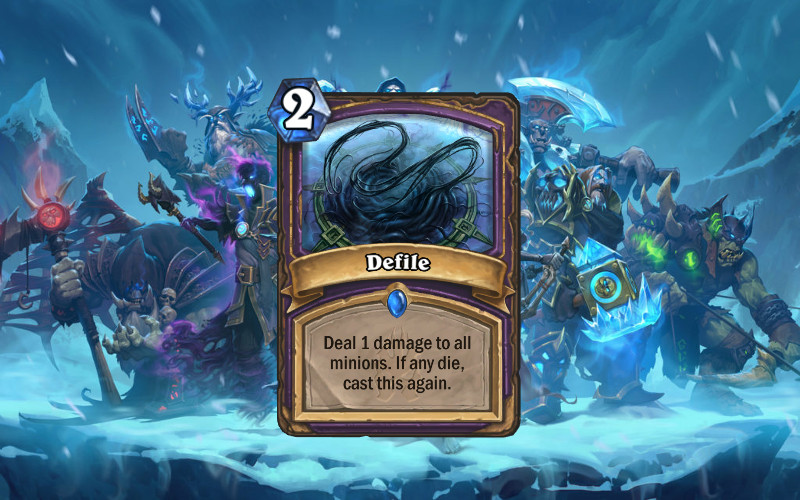
Even Ultimate Infestation might have been okay, but for the other additions made to Druid's toolkit in the form of Spreading Plague, which provides an unbelievably good roadblock against rush decks (so good that it's been nerfed), and Malfurion the Pestilent, which is another versatile tool that can be used to slow the opponent down or push damage. Malfurion is probably the most boring of all the Hero Cards, but also easily one of the strongest. The result is that Druid is currently the most busted class I can recall since the glory days of Starving Buzzard Hunter. According to Vicious Syndicate's data it represents 27.8 of the ladder, and skews higher than that the closer you get to legendary rank.
Whilst neither of Druid's main decks are unbeatable, they are incredibly tedious to keep facing. I regularly see pros posting their deck tracker histories showing a relentless stream of Druid opponents, and many of them have taken to labelling their streams as 'nerf waiting rooms'. That's not good for the game, but again I'm loath to criticise Blizzard too much for not intervening sooner. We're in the middle of the regional championships, so if the nerf bat had been swung immediately a lot of those same players would have cried about their prep being ruined.
Cold comfort
The real lesson I think we've learned from Frozen Throne is how futile trying to predict the meta actually is. Certainly it seems like Blizzard's own internal testing can't accurately assess what's likely to happen when a new set lands, and that should come as little surprise given that Hearthstone remains a game played by millions daily. It almost feels like we stumbled into the relatively healthy Un'Goro meta thanks to set rotation, and something like normal service has now been resumed. We'll soon see how much effect today's balance patch has. Despite the slightly patronising explanation provided, it'll be fascinating to find out if the change to Fiery War Axe finally defangs Pirate Warrior. Equally I'm worried that the nerfs may leave the path open for Priest, which is untouched by the changes, to become even more irritating.
Perhaps a 'one in, one out' approach [to set rotation] would be a better solution.
Longer term, I wonder if Blizzard needs to think harder about how it can ensure certain decks don't remain dominant for years at a time, even if that means sending cards to live in the Hall of Fame with poor old Ragnaros slightly more often than once a year. No one wants a repeat of the Shamanstone era, but the way set releases are currently structured seems to invite that very problem. Perhaps a 'one in, one out' approach would be a better solution. You'd get a less dramatic shake-up at the start of the year, but each subsequent set would have a better shot at shaking things up. As things stand, perhaps it's only correct that an expansion starring the Lich King has brought its fair share of trauma to go with the fun.
With over two decades covering videogames, Tim has been there from the beginning. In his case, that meant playing Elite in 'co-op' on a BBC Micro (one player uses the movement keys, the other shoots) until his parents finally caved and bought an Amstrad CPC 6128. These days, when not steering the good ship PC Gamer, Tim spends his time complaining that all Priest mains in Hearthstone are degenerates and raiding in Destiny 2. He's almost certainly doing one of these right now.


